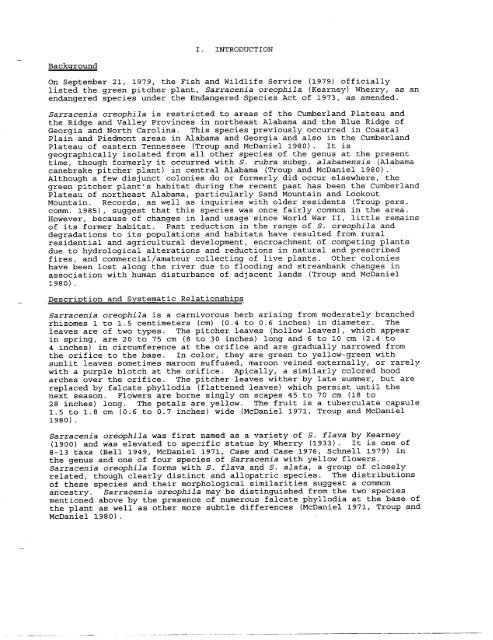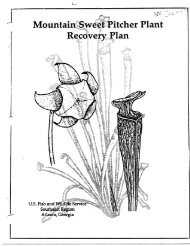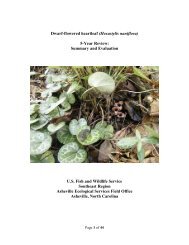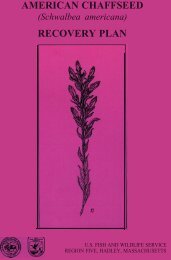Green Pl tcher Plant - Herbarium
Green Pl tcher Plant - Herbarium
Green Pl tcher Plant - Herbarium
Create successful ePaper yourself
Turn your PDF publications into a flip-book with our unique Google optimized e-Paper software.
I. INTRODUCTION<br />
Backc~round<br />
On September 21, 1979, the Fish and Wildlife Service (1979) officially<br />
listed the green pi<strong>tcher</strong> plant, Sarracenia oreophila (Kearney) Wherry, as an<br />
endangered species under the Endangered Species Act of 1973, as amended.<br />
Sarracenia oreophila is restricted to areas of the Cumberland <strong>Pl</strong>ateau and<br />
the Ridge and Valley Provinces in northeast Alabama and the Blue Ridge of<br />
Georgia and North Carolina. This species previously occurred in Coastal<br />
<strong>Pl</strong>ain and Piedmont areas in Alabama and Georgia and also in the Cumberland<br />
<strong>Pl</strong>ateau of eastern Tennessee (Troup and McDaniel 1980) . It is<br />
geographically isolated from all other species of the genus at the present<br />
time, though formerly it occurred with S. rubra subsp. alabamensis (Alabama<br />
canebrake pi<strong>tcher</strong> plant) in central Alabama (Troup and McDaniel 1980).<br />
Although a few disjunct colonies do or formerly did occur elsewhere, the<br />
green pi<strong>tcher</strong> plant’s habitat during the recent past has been the Cumberland<br />
<strong>Pl</strong>ateau of northeast Alabama, particularly Sand Mountain and Lookout<br />
Mountain. Records, as well as inquiries with older residents (Troup pers.<br />
comm. 1985) , suggest that this species was once fairly common in the area.<br />
However, because of changes in land usage since World War II, little remains<br />
of its former habitat. Past reduction in the range of S. oreophila and<br />
degradations to its populations and habitats have resulted from rural<br />
residential and agricultural development, encroachment of competing plants<br />
due to hydrological alterations and reductions in natural and prescribed<br />
fires, and commercial/amateur collecting of live plants. Other colonies<br />
have been lost along the river due to flooding and streambank changes in<br />
association with human disturbance of adjacent lands (Troup and McDaniel<br />
1980)<br />
Description and Systematic<br />
Relationships<br />
Sarracenia oreophila is a carnivorous herb arising from moderately branched<br />
rhizomes 1 to 1.5 centimeters (cm) (0.4 to 0.6 inches) in diameter. The<br />
leaves are of two types. The pi<strong>tcher</strong> leaves (hollow leaves), which appear<br />
in spring, are 20 to 75 cm (8 to 30 inches) long and 6 to 10 cm (2.4 to<br />
4 inches) in circumference at the orifice and are gradually narrowed from<br />
the orifice to the base. In color, they are green to yellow-green with<br />
sunlit leaves sometimes maroon suffused, maroon veined externally, or rarely<br />
with a purple blotch at the orifice. Apically, a similarly colored hood<br />
arches over the orifice. The pi<strong>tcher</strong> leaves wither by late summer, but are<br />
replaced by falcate phyllodia (flattened leaves) which persist until the<br />
next season. Flowers are borne singly on scapes 45 to 70 cm (18 to<br />
28 inches) long. The petals are yellow. The fruit is a tuberculate capsule<br />
1.5 to 1.8 cm (0.6 to 0.7 inches) wide (McDaniel 1971, Troup and McDaniel<br />
1980)<br />
Sarracenia oreophila was first named as a variety of S. flava by Kearney<br />
(1900) and was elevated to specific status by Wherry (1933) . It is one of<br />
8-13 taxa (Bell 1949, McDaniel 1971, Case and Case 1976, Schnell 1979) in<br />
the genus and one of four species of Sarracenia with yellow flowers.<br />
Sarracenia oreophila forms with S. flava and S. alata, a group of closely<br />
related, though clearly distinct and allopatric species. The distributions<br />
of these species and their morphological similarities suggest a common<br />
ancestry. Sarracenia oreophila may be distinguished from the two species<br />
mentioned above by the presence of numerous falcate phyllodia at the base of<br />
the plant as well as other more subtle differences (McDaniel 1971, Troup and<br />
McDaniel 1980)






